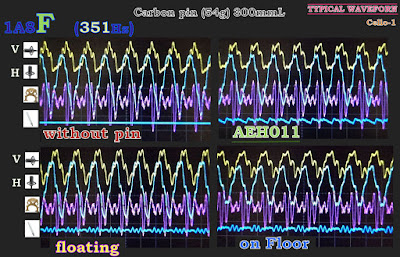[ 09/30/2019 ] Labels: 84.Solution & Study3
A(221Hz)-G(393Hz) notes on A-string were studied by testing carbon endpin(first, attached below), steel-pipe endpin(next post) and titanium endpin.
Typical waveform of each note and each endpin will be listed.
Measured data at bridge(3) give us interference-like beats with big amplitude, they probably are the motion from the friction of bow hair against the string, however the influence to sound/mechanical resonance seems limited. The biggest interest is 'Can an endpin really amplify the resonance of cello body at A-string area'.
A線上のA(221Hz)-G(393Hz)音のボーイングでの典型的な波形を眺めてみる。
(まず、Carbonエンドピン、次いでスチールパイブエンドピン、チタンエンドピンの順。)
駒(測定点3)で 大きな振幅をとらえているが、うなりのように増減している波形は弦と弓の摩擦をとらえていると推測される。実際に発生音・表板/エンドピンとの共振について 影響は大きくないように思われる。
床上にエンドピン先端を置いた時の発生音の波形と振幅強度を注目する必要がある。













